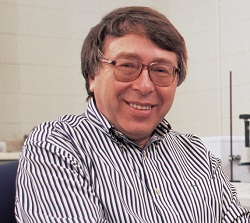There’s a good chance that you may be using some form of technology that Roman had a hand on. From 1990 to 1995, this Russian-born nuclear physicist was one of the leaders of the Russian Governmental Program in Technology Transfer. During that period, his team successfully transferred technologies with an average value of $20 million to $250 million to the West.
In the mid-1990s, Roman moved to Canada through an intergovernmental exchange program and eventually gained his Canadian citizenship. He later became the founding director of the Institute for Diagnostic Imaging Research (IDIR) in Windsor; Ont. Roman is also the University of Windsor’s Distinguished Professor of the Department of Physics and one of Canada’s pre-eminent solid state physicists and educators.
The IDIR conducts applied research, develops products, and handles product commercialization for a growing list of regional, national and international clients. The organisation has experts in the areas of acoustical imaging, quantitative material characterization, real-time non-destructive quality control, digital signal processing, biometrics, non-invasive diagnostics, histological acoustical microscopy, biomaterials and coatings, nano-structured materials, and cold gas dynamic spray.
Q How did you start out in this industry?
Over the last 30 years, I have been deeply involved in high-resolution imaging and everything related to this area including image and/or signal processing, development of advanced recognition processes, digital morphology, top encryption, etc. All this general knowledge can be applied to a vast array of subjects, such as microscopy, histology, image analysis of various defects, face recognition, fingerprint, etc. Some of these applications are directly related to the important biometrics field, forensic science, as well as defence and homeland security.

Q What is your role in your organisation today?
In current role is director of the Institute for Diagnostic Imaging Research, I spearhead a team of international researchers. When I created, this institute about ten years ago it was a priority for me to put together a professional and highly enthusiastic team.
Q What was your most challenging moment?
For me, the most challenging moment was identifying the right strategic partner in Canada who would have a clear understanding what they would like to achieve in terms of new security tools as well as have the necessary human and financial resources to support such a project. In the field of defence and security, we do not have enough knowledge and experience yet and this is our biggest challenge.
Q What is the best advice you received?
The best advice I received was when I began to work with big industry in Canada in 1995. One highly experienced and respected executive said that if I want to be successful in an inter-disciplinary area with many possible directions and solutions, I need to carefully revise each of them and to say no to most, choosing only one and fully concentrate on that.
Q What was your aha moment?
The biggest revelation was finally seeing the results of the development of our 3D fingerprint project. We are able to see tiny details in the internal structure of the last phalange of the finger including dactylogram details, sweat pores, epidermis structure, blood flow, and all of this is dynamic, so, if necessary, you can monitor a finger bone in real-time.
Q What is the one thing that gets you fired up?
During the last few years, I have had a chance to talk to some leading experts in defence, security and biometrics in the US, Canada, UK. I was deeply satisfied with their reactions and comments about possible applications of our prototype in their practices.
Q What habit has contributed to your success?
To achieve success, you need to really love what you are doing and you need to create the proper spirit in your work environment to enjoy your work. I try to start every day with that enthusiasm.
Q What organisation best embodies the innovation mindset?
I think of Google, Facebook, Tesla and some other similar high-tech teams have in the last few years, brought enormous innovation to the market and still continue to do.
Questions about the Institute for Diagnostic Imaging Research
Q How is your organisation changing the game within your industry?
Established in 2008, the Institute for Diagnostic Imaging Research is a multi-disciplinary, collaborative research and innovation centre whose primary focus is the development of innovative diagnostic imaging techniques and products. We not only conduct research but also develop products and handle product commercialization for a growing list of regional, national and international clients.
Q What are the biggest impediments to innovation in your industry?
In the innovation sector, the most difficult step is to find funding that will support the transition of your idea to commercial prototyping. From my point of view, to make this step easier, government funding agencies can be of great help.
Q How has innovation become engrained in your organisation’s culture?
At the Institute for Diagnostic Imaging Research, you will find scientists from around the world, each a leader in their field, along with highly-trained personnel. Another crucial point is the selection of projects which need to be related to our expertise. By tapping into this talent pool and developed infrastructure, the IDIR has been able to accomplish world-class, benchmark-setting applied research and continuously strives to innovate and generate new ideas.
Q What technologies, business models and trends will drive the biggest changes in your industry?
To continue to stay on the cutting-edge in my area of expertise, we need to follow the most advanced achievements in IT, the most efficient algorithms for image and signal processing and to use most innovative electronic solutions in our practice. Today, you need to do nonstop monitoring and find the best products that can be used for your projects. As a result, our business model became really international; we have more than a dozen partners and co-suppliers from different countries, which is a trend that will only continue in the future.